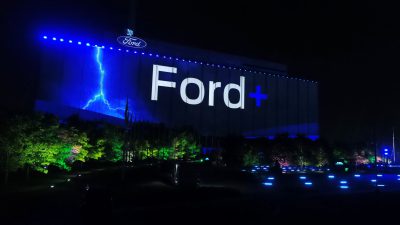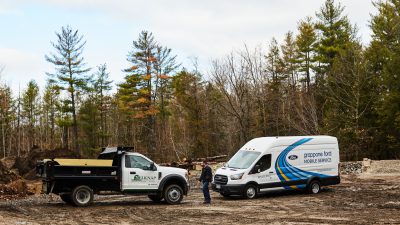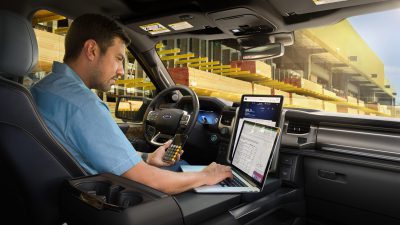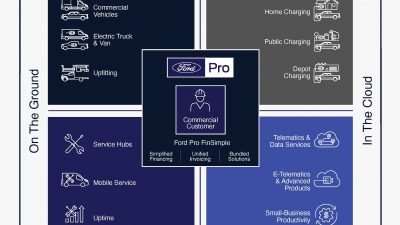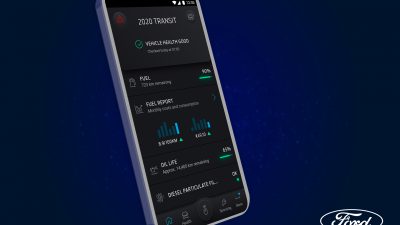- Ford geeft details over prioriteiten van Ford+ plan voor groei en waardecreatie, gebaseerd op ‘always-on’ klantenrelaties en leiderschap in elektrische voertuigen en verbonden diensten
- Verwachting is dat 40% van wereldwijde Fords tegen 2030 volledig elektrisch is; geplande investeringen in elektrificatie worden verhoogd tot meer dan $30 miljard tegen 2025, inclusief ontwikkeling van IonBoost-batterijen
- Oprichting van Ford Pro Vehicle Services and Distribution Business aangekondigd; volledig gericht op hoge productiviteitseisen van bedrijven en overheidsinstanties
- Ford Pro gebruikt technologie van het asfalt tot aan de cloud om inzetbaarheid, gebruikskosten en prestaties van wagenparken met zowel EV’s als ICE voertuigen te helpen verbeteren
Elektrische voertuigen en geavanceerde connectiviteit veranderen het commerciële en particuliere vervoer. Ford loopt voorop in die wereldwijde revolutie – met aantrekkelijke diensten en platforms gebaseerd op geavanceerde elektrische architecturen en batterijtechnologieën. Lees verder
Downloads
Het bedrijf gebruikt onder andere deze innovaties om Ford Pro vorm te geven. Zo is Ford de eerste autofabrikant met een volledig eigen dienstverlenings- en distributiebedrijf voor bedrijfswagens.
Lees het bericht hieronder verder in het Engels:
And the underlying Ford+ plan for growth promises always-on benefits for customers – along with new ways for investors to think about how they value the company.
Those are the primary takeaways Wednesday May 26th when Ford CEO Jim Farley and other senior leaders expand on the company’s customer-focused strategic ambitions and actions in a virtual meeting – themed “Delivering Ford+” – with financial analysts and other stakeholders. Access and supporting material can be found at shareholder.ford.com.
“I’m excited about what Ford+ means for our customers, who will get new and better experiences by pairing our iconic, world-class vehicles with connected technology that constantly gets better over time,” said Farley. “We will deliver lower costs, stronger loyalty and greater returns across all our customers.
“This is our biggest opportunity for growth and value creation since Henry Ford started to scale the Model T, and we’re grabbing it with both hands.”
Delivering Ford+
During the event, Farley will relate how Ford is breaking away from the transactional, build-and-sell business model that has typified the auto industry for decades. Instead, Ford+ is characterized by close, enduring customer relationships – enabled by the company’s foundational strengths, improving financial performance, and capabilities and investments in disruptive technologies.
At the core of those capabilities is Blue Oval Intelligence, Ford’s next-generation, cloud-based platform for integrating electrical, power distribution, computing and software systems in connected Ford and Lincoln vehicles.
Presentations will detail where, why and how the company is headed with fully electric vehicles, commercial solutions and connected services – and how customers will benefit. CFO John Lawler said Ford is allocating capital to those priority areas to produce value for customers and shareholders.
“We’re fueling Ford+ by further strengthening our core automotive operations and generating consistently healthy cash flow that will fund growth and create value,” said Lawler.
The company expects to deliver an 8% adjusted EBIT (earnings before interest and taxes) margin in 2023.1
Today’s event will address how Ford is:
Leading the Electrification Revolution
- Accelerating investments and increasing planned total spending on electrification, including battery development, to more than $30 billion by 2025 – while deriving efficiencies from Ford’s flexible EV architecture and modular technologies.
- Anticipating 40% of Ford’s global vehicle volume to be fully electric by 2030, including from:
- Mustang Mach-E, which is bringing new customers to Ford – 70% of buyers, to date
- The F-150 Lightning, an all-electric version of the world’s most popular pickup truck, which has amassed 70,000 customer reservations since it was unveiled one week ago, and
- E-Transit commercial vans, which will be on the road later this year.
- Investing in battery technology and equipping Ford to design, engineer and manufacture its own batteries, with key developments including:
- Creating Ford Ion Park, a global center of battery excellence comprising more than 150 experts in battery chemistries, testing, manufacturing and value-chain management who will boost battery range and lower costs to customers and Ford
- Vertically integrating battery technology with an extensive range of EV batteries – IonBoost lithium ion; IonBoost Pro lithium iron phosphate for commercial vehicles; and long-range, low-cost solid-state batteries based on Ford’s own engineering and know-how from Solid Power, in which the company holds an equity stake, and
- Forming a joint venture, BlueOvalSK, with SK Innovation to manufacture battery cells and arrays at two plants in the U.S. for future Ford and Lincoln vehicles.
Creating a Business Dedicated to Commercial Customers
- Establishing Ford Pro, a global vehicle services and distribution business within Ford devoted to commercial and government customers, and led by Ted Cannis, who’s been named CEO and a corporate officer.
- Cannis has been head of Ford’s North America CV business and previously managed the Team Edison EV development group.
- Providing customers with greater value and higher productivity through:
- The industry’s most comprehensive and flexible range of electric and internal-combustion commercial vehicles
- Digital and physical services that can help optimize and maintain customer fleets
- Public, depot and employee home charging of EVs for the next day’s work, and
- Bundled financing of vehicles, services and charging.
- Increasing the commercial market for hardware and adjacent and new services that’s addressable by Ford – with anticipated company revenue of $45 billion by 2025, up from $27 billion in 2019.
Connecting With Customers via Connected Services
- Having about 1 million vehicles that are capable of receiving over-the-air system updates on the road by the end of this year, exceeding Tesla’s volume by July 2022, and scaling to
33 million OTA-enabled Ford and Lincoln vehicles by 2028. - Strengthening customer relationships with digitally enabled tools like Ford Pass and Lincoln Way, online ordering, simplified financing and renewal options, vehicle pick-up and delivery, and mobile repairs.
- Extending digital lifestyles by fully integrating best-in-class technology from, e.g., Apple, Amazon, Google and Baidu.
- Speeding detection and resolution of quality issues using connected data – helping to raise customer satisfaction and lower warranty costs.
- Deploying distinctive connected functions like Ford’s BlueCruise driver-assist technologies, new features and upgraded software content, and EV charging to improve the user experience – and capitalize on what is projected to be a $20 billion market for such services by 2030.
Ford Pro
Ford, which already helps commercial customers “own work” with the world’s most popular pickup trucks and vans, now plans to redefine success for those customers with Ford Pro – a global vehicle services and distribution business that will increase uptime and reduce ownership costs, leading to higher productivity and performance.
The new business – separate within Ford and the first of its kind among automakers – is a major outcome of the Ford+ plan for growth and value creation, which is based on building enduring, always-on customer relationships.
“Ford Pro will redefine the market for commercial vehicles and services, where Ford is already the leader around the world,” said Ford CEO Jim Farley. “We’re creating a one-stop shop to help those customers increase uptime and productivity while reducing complexity and the total cost of ownership.”
A foundational strength of Ford Pro is the industry’s most comprehensive and flexible range of F-Series and Ranger trucks, as well as Transit, the world’s best-selling cargo van – and seamless upfitting of all of them. Soon, Ford will start making high-volume electric vehicles, including the E-Transit later this year and the F-150 Lightning Pro in mid-2022, which Ford Pro will pair with commercially focused charging solutions.
In addition to expected benefits for customers, Ford Pro’s ambitions for itself are significant. The company anticipates its growing capabilities and appeal to generate $45 billion in revenue from hardware and adjacent and new services by 2025 – up from $27 billion in 2019. In North America, Ford’s share of Class 1 through Class 7 full-size trucks and vans today exceeds 40%. In Europe, Ford has been the leading commercial vehicle brand for six consecutive years.
Farley said Ford Pro will be led by Ted Cannis as CEO. Cannis will collaborate with Hans Schep, general manager of Commercial Vehicles for Ford of Europe, and other regional leaders. Cannis currently heads Ford’s North America CV business and previously was leader of the Team Edison electric-vehicle development group.
Redefining, Unlocking Commercial Customer Value
Ford Pro, which will implement new services in phases, is aimed squarely at helping commercial customers work better, with productive, durable and smart vehicles and connected services.
Ford today has trusted relationships with nearly 125,000 commercial and government fleet customers in North America and thousands more in Europe and elsewhere. Ford Pro is designed to even more rapidly and cost-effectively anticipate and address their needs and those of new customers.
“We’re going to give commercial customers even more reasons to choose and rely on Ford,” said Cannis. “Our team understands that when customers win, we win, so we’re completely focused on unlocking tremendous value for them.”
Ford Pro will integrate, digitize and simplify transportation with capabilities spanning:
- Ford Pro Vehicles – including Ford’s broad lineup of combustion-engine and hybrid commercial vehicles and, soon, all-electric versions of the company’s industry-leading vans and full-size pickup trucks developed for commercial use
- Ford Pro Charging – hardware and software solutions for public, depot and overnight home charging of EVs so they’re ready to work again the next day
- ·Ford Pro Intelligence – digital services, with distinct features integrated in their vehicles that enable customers to better manage and maintain their fleets
- Ford Pro Services Elite – expanding Ford’s strong network of CV centers by adding 120 dedicated, large-bay service hubs across the United States with extended hours and rapid turnaround, plus introducing 1,200 mobile service vehicles by 2025 to meet customers where they are, save them money and get them back in business, and
- Ford Pro FinSimple – bundled financing for vehicles, services and EV charging.
Some elements of Ford Pro commercial services have already been introduced and are now being expanded in Europe, among them the recently launched Ford Fleet Management and Ford Pro Liive. The latter is a connected uptime system expected to reduce downtime of customer fleets by up to 60%. Such enhanced services are generating higher levels of customer satisfaction and loyalty, and growth for Ford.
Ford Pro will initially launch in North America and Europe. More information can be found at fordpro.com.
# # #
1When Ford provides guidance for adjusted EBIT margin, it does not provide guidance for the most comparable GAAP measure because, as described in more detail in “Non-GAAP Financial Measures That Supplement GAAP Measures” in Ford’s Annual Reports on Form 10-K and Quarterly Reports on Form 10-Q, the GAAP measure includes items that are difficult to predict with reasonable certainty.
Cautionary Note on Forward-Looking Statements
Statements included or incorporated by reference herein may constitute “forward-looking statements” within the meaning of the Private Securities Litigation Reform Act of 1995. Forward-looking statements are based on expectations, forecasts, and assumptions by our management and involve a number of risks, uncertainties, and other factors that could cause actual results to differ materially from those stated, including, without limitation:
- Ford and Ford Credit’s financial condition and results of operations have been and may continue to be adversely affected by public health issues, including epidemics or pandemics such as COVID-19;
- Ford is highly dependent on its suppliers to deliver components in accordance with Ford’s production schedule, and a shortage of key components, such as semiconductors, can disrupt Ford’s production of vehicles;
- Ford’s long-term competitiveness depends on the successful execution of its Plan;
- Ford’s vehicles could be affected by defects that result in delays in new model launches, recall campaigns, or increased warranty costs;
- Ford may not realize the anticipated benefits of existing or pending strategic alliances, joint ventures, acquisitions, divestitures, or new business strategies;
- Operational systems, security systems, and vehicles could be affected by cyber incidents and other disruptions;
- Ford’s production, as well as Ford’s suppliers’ production, could be disrupted by labor issues, natural or man-made disasters, financial distress, production difficulties, or other factors;
- Ford’s ability to maintain a competitive cost structure could be affected by labor or other constraints;
- Ford’s ability to attract and retain talented, diverse, and highly skilled employees is critical to its success and competitiveness;
- Ford’s new and existing products and mobility services are subject to market acceptance and face significant competition from existing and new entrants in the automotive and mobility industries;
- Ford’s results are dependent on sales of larger, more profitable vehicles, particularly in the United States;
- With a global footprint, Ford’s results could be adversely affected by economic, geopolitical, protectionist trade policies, or other events, including tariffs;
- Industry sales volume in any of Ford’s key markets can be volatile and could decline if there is a financial crisis, recession, or significant geopolitical event;
- Ford may face increased price competition or a reduction in demand for its products resulting from industry excess capacity, currency fluctuations, competitive actions, or other factors;
- Fluctuations in commodity prices, foreign currency exchange rates, interest rates, and market value of Ford or Ford Credit’s investments can have a significant effect on results;
- Ford and Ford Credit’s access to debt, securitization, or derivative markets around the world at competitive rates or in sufficient amounts could be affected by credit rating downgrades, market volatility, market disruption, regulatory requirements, or other factors;
- Ford’s receipt of government incentives could be subject to reduction, termination, or clawback;
- Ford Credit could experience higher-than-expected credit losses, lower-than-anticipated residual values, or higher-than-expected return volumes for leased vehicles;
- Economic and demographic experience for pension and other postretirement benefit plans (e.g., discount rates or investment returns) could be worse than Ford has assumed;
- Pension and other postretirement liabilities could adversely affect Ford’s liquidity and financial condition;
- Ford could experience unusual or significant litigation, governmental investigations, or adverse publicity arising out of alleged defects in products, perceived environmental impacts, or otherwise;
- Ford may need to substantially modify its product plans to comply with safety, emissions, fuel economy, autonomous vehicle, and other regulations;
- Ford and Ford Credit could be affected by the continued development of more stringent privacy, data use, and data protection laws and regulations as well as consumers’ heightened expectations to safeguard their personal information; and
- Ford Credit could be subject to new or increased credit regulations, consumer protection regulations, or other regulations.
We cannot be certain that any expectation, forecast, or assumption made in preparing forward-looking statements will prove accurate, or that any projection will be realized. It is to be expected that there may be differences between projected and actual results. Our forward-looking statements speak only as of the date of their initial issuance, and we do not undertake any obligation to update or revise publicly any forward-looking statement, whether as a result of new information, future events, or otherwise. For additional discussion, see “Item 1A. Risk Factors” in our Annual Report on Form 10-K for the year ended December 31, 2020, as updated by subsequent Quarterly Reports on Form 10-Q and Current Reports on Form 8-K.


